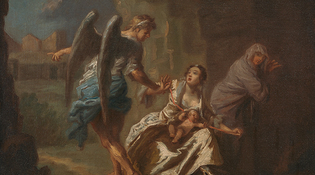 loading
loading
Arts & CultureSave the childrenObject lesson: a painting celebrates a London orphanage. Joanna Marschner, senior curator at Historic Royal Palaces, is based at Kensington Palace in London.  Yale Center for British Art, Paul Mellon CollectionThe Angel of Mercy, by English artist Joseph Highmore (1692–1780), shows an angel forestalling a murder. The painting, part of the collection of the Yale Center for British Art, appears in the exhibit Enlightened Princesses: Caroline, Augusta, Charlotte, and the Shaping of the Modern World (at Kensington Palace in London from June 22 through November 12). View full imageJoseph Highmore painted The Angel of Mercy in about 1746. It depicts a young woman, respectably dressed yet seated in a rough and gloomy recess, who has been interrupted in the desperate act of strangling her tiny baby with a ribbon. An angel has stopped her hand. He gestures to a building that can be glimpsed in the background, bathed in sunshine. It is the London Foundling Hospital, and it will be the salvation of both mother and child. The hospital’s founder was Thomas Coram, a prosperous shipbuilder who had seen in many ports the damage caused by transient mariners who engaged in illicit relationships with local women. After retiring to Rotherhithe, in London, and observing in the city many abandoned infants—some dead, others dying—he eventually resolved in 1722 to build a foundling hospital. Poorly educated, and relatively rough mannered, he struggled to find patrons for his venture. But in 1729, he had a fund-raising breakthrough with a “Ladies Petition” backed by Caroline of Ansbach, queen consort to King George II. Caroline (1683–1737) was one of three German princesses whose intellectual abilities and philanthropy helped shape English culture of the day, and who were celebrated in the recent Enlightened Princesses exhibit at the Yale Center for British Art. Caroline had been brought up in the court in Berlin and had joined its lively intellectual circle, which included the natural philosophers Gottfried Leibniz, John Toland, and Pierre Bayle, as well as the composer George Frideric Handel. It is very likely that she would have become aware of the orphanages established by August Hermann Franke in nearby Halle, in which abandoned children were raised to become useful members of society. To assist Coram’s venture, Caroline commissioned research into other European foundations set up for the support of children. The Foundling Hospital opened its doors in 1741, first in temporary quarters, then in the building seen in Highmore’s painting. By this date Caroline had died, but her daughter-in-law, Augusta of Saxe-Gotha (1719–1772)—and later Augusta’s daughter-in-law Charlotte of Mecklenburg-Strelitz (1744–1818), the wife of King George III—continued to provide substantial financial support. As mothers themselves, overseeing the health and education of their own children and grooming them to take their places in European royal dynastic networks, they extended their role to improving the welfare of children more generally. The foundlings would be raised and educated in practical trades; these were not lives to be wasted by poverty. The participation of the royals brought great popular interest. And Coram himself had friends in the London entrepreneurial class who contributed. Handel, by now living in London, donated an organ for the hospital chapel and established an annual program of concerts that brought in fashionable and wealthy crowds. Besides Highmore, Coram’s artistic supporters included Richard Wilson, Thomas Gainsborough, and William Hogarth. All presented paintings for the hospital’s public rooms. The Angel of Mercy, though intended for the hospital, never hung there. Highmore seems to have had second thoughts about its stark commentary; the issue of infanticide, shocking in itself, would raise in viewers’ minds the questions of prostitution and rape. This painting remained in his studio, and he presented the hospital with another work. But Caroline, Augusta, and Charlotte embraced the spirit of Highmore’s first intention. These royal women, bold in their ambition to contribute to the betterment of society, broke with prevalent mores: each would support refuges for abandoned and destitute women and for prostitutes. As for the Foundling Hospital, it lives on as Coram, a nonprofit dedicated to helping children in the United Kingdom.
The comment period has expired.
|
|